see https://cyb-mes.net/2-UGR.htm#the-system-of-digital-books
Back to top: The cluster: an overview
Overview
The UGR system includes a number of websites articulated in five major sections, as indicated graphically in the logo to the right:
- the section on the system has a broad application beyond any given site;
- the sectokn on area and units constitute the documentary building blocks of the Urkesh data system; and
- the three thematic sections give the interpretive framework forthe site as a whole and the major categories of finds.
There is currently a total of 30 websites or digital books in the system: they are listed on the sidebar to the right.
|
|
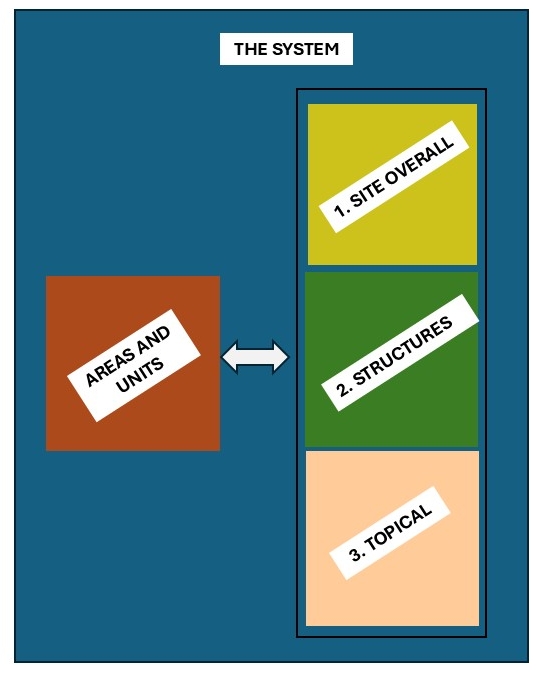
|
In the sidebar to the right, the color code is as following:
- yellow bold italic, linked: sites near completion
- yellow regular font, linked: sites in advanced state of elaboration
- white, linked: sites in a preliminary phase of elaboration
- white, not linked: sites that are planned
Back to top: The cluster: an overview
The UGR system
The system’s websites are tightly interrelated with each other, and it is in this sense that they constitute properly a system, and not just a collection of data.
The order in which they are presented in the logo shown above reflects the logic of how the websites can be read – as different from the sequence with which they are written (see under Implementation).
“Reading” the system implies that there is a wholeness which undergirds the pieces, and the sequence evidenced by the numbers indicates how this wholeness is structured. Re-educating ourselves to the need of “read.ing” websites is a major methodological aim of our project (see above), and the UGR cluster is a prime example of how this happens. It is an an effective implementation of the interplanarity concept
Back to top: The cluster: an overview
The Cybernetica Mesopotamica system
The UGR system is part of a larger project, named Cybernetica Mesopotamica, which deals with other aspects of Mesopotamian civilization.
Two websites within this system are particularly revlevant for the UGR.
|
|
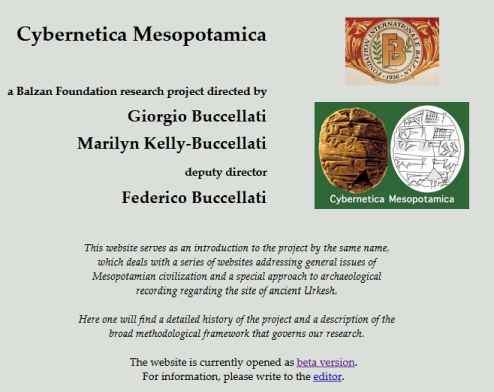
|
The first is the one entitled Digital Discourse: it develops at length the theoretical basis for an in depth systemic understanding of how websites should be used as conveyors of a special interplanar strucuring of arguments – of which the UGR is a prime example.
|
|
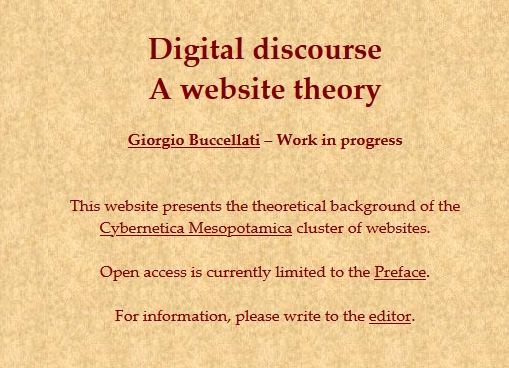
|
Back to top: The cluster: an overview
The hub website
The urkesh.org website serves as the hub that gives an overview of the entire project. Within it, the section on the record serves as an entry to the UGR system as a whole.
A brief description of each section of the UGR system follows, the number indicating the number of websites currently near completion or in preparation. The backgound color (as in the logo above) identifies each of the five sections:
Methodology – 2
1. Sitewide – 2
2. Structures – 3
3. Topical: Movable finds – 7
4. Excavations units – 16
|
|
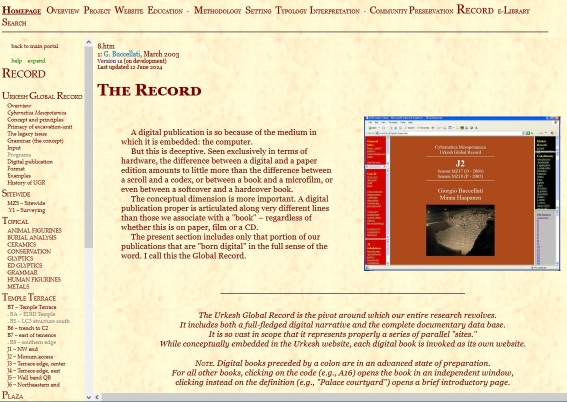
|
Back to top: The cluster: an overview
The system
The development of the methodology followed step by step the implementation of the system.
In one sense it preceded the implementation as set in motion by all the other websites, since method determined not only their structure and organization, but also, and especially, their approach to the data – it was, we may say, the underlying philosophy.
On the other hand, it followed, in the measure in which it became more clearly articulated as the implementation suggested revisions and changes.
The UGR website (which you are reading at the moment) defines the broad outline of the system, while the Grammar and the Manual websites narrow down the specifics of the coding used especially in the Units websites.
|
|
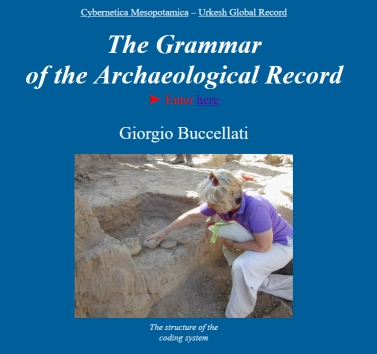
|
Back to top: The cluster: an overview
Thematic websites
Three types of thematic websites (for a total of 12) introduce the reader to the overall results of the excavations.
- Mozan general
- Structures and the built environment
- Movable finds divided by topics
Back to top: The cluster: an overview
1. Site overall
The site as a whole is what confronts us before any excavation takes place, and it remains the critical focal point of interest throughout the excavations.
The Mozan sitewide digital book serves as the overall point of reference for this holistic understanding of the archaeological site: while urkesh.org, as the hub website of the system, serves as a broad introduction to the project, the Mozan Sitewide digital book gives the full technical framework within which the details are to be seen.
Other digital books in this section deal with specific aspects of the work that impact the very physiognomy of the "tell" and straddle across all excavation units. The first ones to be completed are the one on the conservation of the built environment and of the excavation shell that contains it, and the electronic Library website.
|
|

|
Back to top: The cluster: an overview
2. Structural
The built environment of the ancient city comes to light gradually, as the excavations progress, and we can distinguish two types of structural complexes.
The first includes complex structures, consisting of either a single building, such as the Tupiksh Palace in area A, or more buildings, as with the sacral area adjacent to the Palace which includes the abi.
The second includes open spaces defined by the structures and access routes, such as the Temple Plaza facing the Terrace edge (image to the right).
|
|
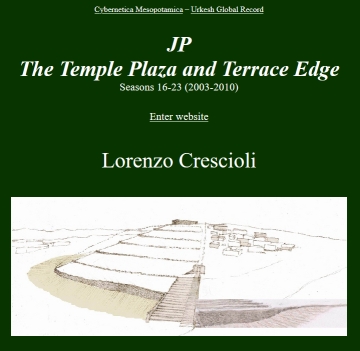
|
Back to top: The cluster: an overview
3. Topical: Movable Finds
Classes of movable finds are organizaed topically into distinct websites that serve a double purpose.
- They provide a full treatment of the categ-orization system used in describing the items in any given class.
- They give a synthetic presentation of the entire corpus analyzed, with a variety of tabulations and statistical overviews.
The Ceramics corpus (shown on the right) is the first of these topical digital books, and serves as a model for the others, each having special sets of programs for the analysis of the data.
Several more are in preparation, as shown in the sidebar to the right, relating to glyptics, choroplastic, metal objects and burial analysis.
|
|

|
Back to top: The cluster: an overview
Excavation Areas
Excavation areas are broad sectors of the site, defined only by topographical, not typological, characteristics. They are listed in the Mozan sitewide site.
A dedicated website is opened n a case where a special cluster of units needs to be considered when they straddle different structures and excavation units, with a variety of chronological levels.
Area AA is one such case. It is a wide area, with a complex stratigraphy. The Royal Palace of Tupkish (AP) is the most important single structure. The unit A12 turned out to be a highly significan sructure, the abi. And the Khabur period graves are another particularly significant cluster of structures, to which a separate website (AH) ought to be dedicated.
|
|

|
Back to top: The cluster: an overview
Excavation Units
Excavation units (currently 16 in numbre) are the building blocks of the documentation system: they contain the primary information and all other digital books refer to them.
While in a reading mode they come last, in a writing mode they are first.
Each unit book presents both the analytical data base and the synthetic interpretation of all the finds and all observations made. Each unit is a self-contained entity, even though it does not, in principle, have any typological identity: it is in fact defined only by volumetric and topographical criteria.
In the sidebar to the right one will find a complete list of the excavation units for which a website has been completed (in yellow) or is in the works (white underscored), and also for those to be done in the future.
|
|

|
Back to top: The cluster: an overview